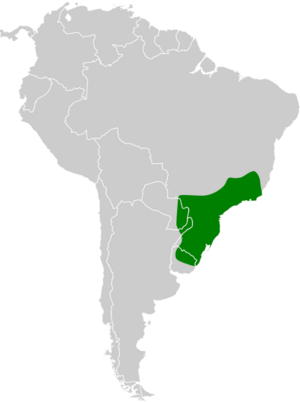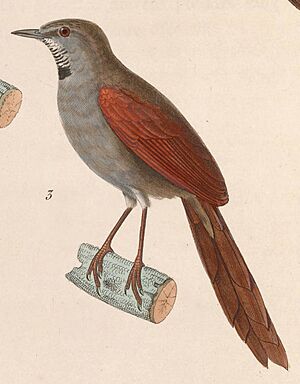Grey-bellied spinetail facts for kids
Quick facts for kids Grey-bellied spinetail |
|
|---|---|
 |
|
| Conservation status | |
| Scientific classification | |
| Genus: |
Synallaxis
|
| Species: |
cinerascens
|
 |
|
The grey-bellied spinetail (Synallaxis cinerascens) is a small bird. It belongs to the ovenbird family, which is known for building unique nests. You can find this bird in parts of Argentina, Brazil, Paraguay, and Uruguay.
Contents
About the Grey-bellied Spinetail
This bird is the only type in its group, meaning it's a monotypic species. It's also closely related to another bird called the ochre-cheeked spinetail. They are like "sister species."
What Does It Look Like?
The grey-bellied spinetail is about 13.5 to 15 centimeters (5.3 to 5.9 inches) long. It weighs around 10 to 14 grams (0.35 to 0.49 ounces). Both male and female birds look the same.
Their face is mostly gray-brown, with dark areas near their eyes. The top of their head is dark brownish-olive. Their back and rump are a richer brown color. Their wings are a beautiful reddish-chestnut.
The tail is dark chestnut. The tips of the tail feathers look spiny because they don't have soft parts. Their chin is whitish, and their throat has black and pale gray spots. The rest of their belly is brownish-gray, with a lighter center.
Their eyes are reddish-brown, and their beak is black. Their legs and feet are greenish-gray. Young birds look similar but have a less clear throat pattern.
Where Does It Live?
The grey-bellied spinetail lives in several South American countries. You can find it in parts of Brazil, eastern Paraguay, and northeastern Argentina. It also lives in northern Uruguay.
This bird prefers to live deep inside dense evergreen forests. It likes both lowland forests and those found on mountains. It also lives in older secondary forests, which are forests that have regrown after being cut down. It avoids the edges of forests. You can find it from sea level up to about 1,150 meters (3,770 feet) high.
Bird Behavior
Movement and Travel
The grey-bellied spinetail stays in the same area all year round. It does not migrate to different places.
What Does It Eat?
This bird eats arthropods, which are creatures like insects and spiders. It usually hunts for food in pairs. They search on the ground and in the lower parts of the forest, up to about 2 meters (6.6 feet) high. They pick their prey from fallen leaves and low plants.
Reproduction and Life Cycle
Scientists believe the grey-bellied spinetail lays eggs during the spring and summer in the southern hemisphere. They are thought to stay with one partner for breeding.
Their nest is a large, round shape made of sticks. It has a tube-like entrance that goes upwards to a hidden chamber inside. The birds line the bottom of this chamber with soft leaves. They build their nest on the ground, in a small dip they dig. A female bird usually lays three eggs. We don't know how long the eggs take to hatch or when the young birds leave the nest.
Bird Calls and Songs
The grey-bellied spinetail's song is a very high, clear sound. It sounds like "weeet-sweet," with the first note being higher than the second.
Conservation Status
The IUCN (International Union for Conservation of Nature) says the grey-bellied spinetail is a species of "Least Concern." This means it's not currently in danger of disappearing. It lives across a large area, but we don't know exactly how many of these birds there are. Their numbers are believed to be going down.
There are no immediate big threats to the bird. It lives in several protected areas. However, a lot of forests where this bird lives have been cut down. This loss of habitat makes the bird more vulnerable because it depends on forests to survive.



